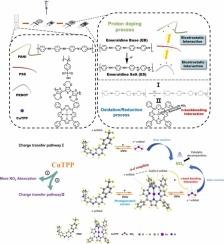Highly selective room temperature NO2 detection via π-back bonding in CuTPP-functionalized conductive polymer sensors
IF 3.7
1区 化学
Q1 CHEMISTRY, ANALYTICAL
引用次数: 0
Abstract
Nitrogen dioxide (NO2), primarily emitted from transportation and industrial activities, poses significant threats to human health and environmental safety. However, reliable, repeatable, highly selective, and sensitive detection of NO2 at room temperature remains challenging. In biological systems, metalloporphyrins are well known for their essential roles in gas transport, storage, and as catalytic centers in enzymatic redox reactions, demonstrating highly refined molecular recognition capabilities. Inspired by these unique gas-metal porphyrin interactions, we incorporated copper tetraphenylporphyrin (CuTPP) into a conductive polymer composite consisting of polyaniline (PANI) and Poly(3,4-ethylenedioxythiophene):polystyrene sulfonate (PEDOT:PSS) to construct a high-performance NO2 sensor operating at room temperature. Upon exposure to NO2, Cu2⁺ ions in CuTPP selectively adsorb NO2 via a non-classical π-back bonding mechanism, which not only ensures high selectivity but also significantly facilitates charge transfer pathways centered around CuTPP, greatly enhancing electron extraction from PANI. For sensor recovery, ultraviolet (UV) was employed to promote the desorption of NO2. The developed sensor exhibits excellent linearity (R2 > 0.97) within an NO2 concentration range of 0.2–1 ppm, and achieves a theoretical detection limit of approximately 0.4 ppb, suitable for monitoring concentrations of NO2 in environmental settings. By exploiting the non-classical π-back bonding interaction between CuTPP and NO2 within a conductive polymer matrix, our approach provides a versatile and low-power strategy for precise NO2 detection, with potential applications in environmental monitoring and assessment.

基于cuppp功能化导电聚合物传感器π-背键的高选择性室温NO2检测
二氧化氮(NO2)主要由交通和工业活动排放,对人类健康和环境安全构成重大威胁。然而,在室温下可靠、可重复、高选择性和灵敏的NO2检测仍然具有挑战性。在生物系统中,金属卟啉因其在气体运输、储存和酶氧化还原反应中的催化中心的重要作用而闻名,表现出高度精细的分子识别能力。受这些独特的气体-金属卟啉相互作用的启发,我们将四苯基卟啉铜(CuTPP)加入到由聚苯胺(PANI)和聚(3,4-乙烯二氧噻吩):聚苯乙烯磺酸盐(PEDOT:PSS)组成的导电聚合物复合材料中,以构建室温下工作的高性能NO2传感器。当Cu2暴露于NO2时,Cu2 +离子在cupp中通过非经典π-背键机制选择性吸附NO2,不仅保证了高选择性,而且显著促进了以cupp为中心的电荷转移途径,大大增强了对PANI的电子提取。在传感器回收方面,采用紫外线(UV)促进NO2的解吸。该传感器在NO2浓度0.2 ~ 1ppm范围内具有良好的线性(R2 > 0.97),理论检测限约为0.4 ppb,适用于环境中NO2浓度的监测。通过利用导电聚合物基体中cuppp与NO2之间的非经典π-背键相互作用,我们的方法为精确检测NO2提供了一种通用的低功耗策略,在环境监测和评估中具有潜在的应用前景。
本文章由计算机程序翻译,如有差异,请以英文原文为准。
求助全文
约1分钟内获得全文
求助全文
来源期刊

Sensors and Actuators B: Chemical
工程技术-电化学
CiteScore
14.60
自引率
11.90%
发文量
1776
审稿时长
3.2 months
期刊介绍:
Sensors & Actuators, B: Chemical is an international journal focused on the research and development of chemical transducers. It covers chemical sensors and biosensors, chemical actuators, and analytical microsystems. The journal is interdisciplinary, aiming to publish original works showcasing substantial advancements beyond the current state of the art in these fields, with practical applicability to solving meaningful analytical problems. Review articles are accepted by invitation from an Editor of the journal.
 求助内容:
求助内容: 应助结果提醒方式:
应助结果提醒方式:


